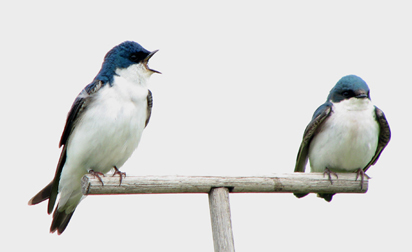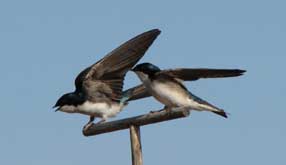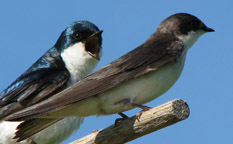At Your Boxes:
The number of swallows investigating your nest boxes is growing as more and more arrive. And one thing is certain, for small birds Tree Swallows can make a racket! You’ll be hearing lots of Tree Swallow song and calls in the weeks to come. Now is a good time to start listening carefully, seeing if you can distinguish specific vocalizations, and noting what situations and behaviors seem to evoke them.

Concepts:
Each songbird species has its own set of vocalizations. Their numbers can range from a few up to hundreds of different calls and songs in some species. Each vocalization is a signal, with a specific purpose, given in specific circumstances. Vocalizations and visual displays are two main tools birds use to communicate with and exert influence over other birds.
Tree Swallow song and calls have many functions, among them:
- Species recognition.
- Sexual recognition.
- Individual recognition.
- Assessing individual quality.
- Impressing potential mates.
- Establishing and maintaining pair bonds.
- Setting and maintaining territory.
- Forming and maintaining dominance hierarchies.
- Attaining extra-pair copulations.
- Maintaining contact with others.
- Sounding predator alarms.
- Mobbing and aggression toward predators.
Ornithologists often distinguish between songs and calls.
Songs:
- Normally are louder, longer, and more complex than calls.
- Are often given from a conspicuous position.
- Are most often produced by males.
- Proclaim a bird’s species and its individual identity.
- Function to repel intruders and defend territory.
- Also function to attract and stimulate the opposite sex.
- Are mostly involved with nesting season activities.
- May not be completely instinctive. In some species young birds must learn their species’ songs by listening.
Calls:
- Are generally shorter and simpler than songs.
- Convey specific messages about immediate, often urgent situations, such as danger, hunger, one’s presence or location.
- Alert others of one’s current mood or intentions.
- May be given by both males and females.
- Are instinctive and understood by all birds of a species. They do not have to be learned.
- May be used outside the nesting season.
Every song and call has its own qualities, including:
- Sound wave frequency.
- Loudness.
- Duration.
- Time between vocalizations.
The possibilities for variation are many, both among species and among individuals of each species. Some vocalizations seem rather simple, while others are extremely complex to our ears. But birds almost certainly hear and interpret sounds quite differently from us. We really don’t know what aspects of songs and calls birds key on.
How does a Tree Swallow produce its song and calls?
- Unlike us, birds don’t have vocal chords in their throats for sound production. Instead they use a completely different sound producing organ, the Syrinx, an organ that only birds possess.
- The syrinx is a box-like chamber of cartilage, with supporting muscles, and membranes that can stretch and vibrate.
- The syrinx (below in pink) is not located in the bird’s throat. Instead, it’s deep in a bird’s chest where its trachea (windpipe) branches into two tubes leading to the its lungs.

- Sounds are produced when air being expelled rapidly from a bird’s lungs passes through the syrinx. As the air flows past, muscles change the syrinx’s shape, and the syrinx’s vibrating membranes generate sound waves.
- The muscles controlling the syrinx can influence the tone, pitch, volume, and rhythm of the sound.
- Unlike us, birds don’t use their mouth or tongue to make major changes in how a vocalization sounds.

What Tree Swallow song and calls can you expect to hear?
Tree Swallows make many different vocalizations throughout the year. Here are five Tree Swallow calls and one song you’re sure to hear during the nesting season.
Tree Swallow Chatter Call: (click name for YouTube video).
- A loud, rapid, repeating monotone she-she-she-sheet.
- You’re certain to hear chattering early in the nesting season as boxes are claimed and pairs formed.
- Both males and females chatter when other swallows approach their nest site.
- Chattering swallows usually appear excited or agitated, flattening their bodies, fluttering their wings, and aiming their heads and directing the calls at approaching swallows (see picture above).
- This combination of postures and sound appear to form a classic territorial defensive display.
- When males chatter at other males it appears to mean “this nest site is mine; keep away.”
- It’s also sometimes possible that when males chatter to females it may mean “this nest site is mine; come see.”
- Females may also chatter to repel intruding females.
Tree Swallow Shriek or Alarm Call: (click name for YouTube video).
- A loud and high-pitched, single or double-noted, peeh or pee-peeh.
- Tree Swallows may add shrieks with chatters as a defensive display when other swallows intrude too closely to their nest sites.
- Shrieks also function as alarm calls when Tree Swallows spot potential predators, especially avian predators. Shrieks tell predators they’ve been seen and stimulate other swallows in the area to either join the shrieking or flee.
- Swallows will probably shriek at you at times when you make box checks.
Tree Swallow Gurgle or Contact Call: (click name for YouTube video).
- A rather soft and low-pitched 2 to 4 note repetition of buli-duli-dullit.
- Although gurgles are heard throughout the nesting season, they’re especially noticeable during pairing as males and females become accustomed to each other as they bond.
- Gurgles vary slightly from swallow to swallow, which probably helps pair members recognize each other’s identity and location.
- Adults also give Gurgles during incubation of eggs and brooding of young when pair members relieve each other at nests.
- Adults sometimes gurgle when they arrive at the nest with food for their young, which may help stimulate the nestlings to beg.
Tree Swallow Anxiety Call: (click name for YouTube video).
- A rather sweet, pure, repeated eur or euree.
- Tree Swallows sometimes give anxiety calls when other swallows approach or intrude near their nest site.
Tree Swallow Ticking Call: (click name for YouTube video).
- A rapid tic-tic-tic-tic.
- Ticking is part of mating behavior. Males tic as they swoop down to perched females just prior to copulation.
- Females sometimes give it to perched males, and in this circumstance it seems to signal her willingness to copulate.
- Tree Swallows also may give a harsh version of the tick when they dive on nest competitors or potential predators
- Some Tree Swallows may tick and dive at you when you make nest checks.
Tree Swallow Song: (click name for YouTube video).
- There is one main Tree Swallow song, and breeding males do most of the singing.
- In contrast to most calls, which are rather monotone, the Tree Swallow song usually includes notes that sweep up and down, plus various chirps and gurgles, all strung together in combinations that vary from bird to bird.
- Song is most commonly heard after pairs are well-established at nest sites. Listen for males singing while females are building nests, and when they are laying and incubating eggs.
- Tree Swallows usually sing while perched near or at the nest site, although they sometimes sing in flight.
- As with most songbirds, Tree Swallow Song seems intended to repel intruders of their own species, to intimidate potential opponents who venture too close to their “center of reproductive interest,” in this case the male’s nest cavity.
As the nesting season at your project advances listen for other, less frequently given vocalizations, and note the situations in which they occur.
Also, listen for individual differences among your swallows; it seems there’s always one that screams alarms at every other swallow that passes, or one that always ticks and dives on you when you check its nest, or one that chatters at an odd pitch or a slower rate. Part of the fun is realizing these birds really are individuals and getting to know some of their quirks.

Questions for the next Topic: Nest Site Competition and Box Claiming.
- Why don’t Tree Swallows spend the winter at your project?
- Where do they go during winter months?
- Why are they back here so early in spring?
————————————————————————————
Home: Tree Swallow Nest Box Projects
Creating Tree Swallow Nest Box Projects
Spring Return
Nesting Season Behavior
Song and Calls
Nest Site Claiming
Pair Formation
Nest Building
Bird Flight
Mating and Paternity
Diary of One Season at Salmon Creek
Monitoring Nest Boxes and Keeping Records
Making Box Checks Keeping Box Records Control Sheets Season Summaries Print Sheets
Banding Your Tree Swallows Banding Adults Banding Nestlings
Tree Swallows in Research Research Bibliography Glossary of Terms